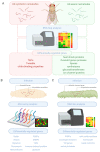Transcriptomic Insights into the Insect Immune Response to Nematode Infection
- PMID: 33573306
- PMCID: PMC7911283
- DOI: 10.3390/genes12020202
Transcriptomic Insights into the Insect Immune Response to Nematode Infection
Abstract
Insects in nature interact with a wide variety of microbial enemies including nematodes. These include entomopathogenic nematodes that contain mutualistic bacteria and together are able to infect a broad range of insects in order to complete their life cycle and multiply, filarial nematodes which are vectored by mosquitoes, and other parasitic nematodes. Entomopathogenic nematodes are commonly used in biological control practices and they form excellent research tools for understanding the genetic and functional bases of nematode pathogenicity and insect anti-nematode immunity. In addition, clarifying the mechanism of transmission of filarial nematodes by mosquitoes is critical for devising strategies to reduce disease transmission in humans. In all cases and in order to achieve these goals, it is vital to determine the number and type of insect host genes which are differentially regulated during infection and encode factors with anti-nematode properties. In this respect, the use of transcriptomic approaches has proven a key step for the identification of insect molecules with anti-nematode activity. Here, we review the progress in the field of transcriptomics that deals with the insect response to nematode infection. This information is important because it will expose conserved pathways of anti-nematode immunity in humans.
Keywords: immunity; infection; insect; nematodes; transcriptomics.
Conflict of interest statement
The authors declare no conflict of interest. The funders had no role in the design of the study; in the collection, analyses, or interpretation of data; in the writing of the manuscript, or in the decision to publish the results.
Figures

Similar articles
-
Nematode infection and antinematode immunity in Drosophila.Trends Parasitol. 2021 Nov;37(11):1002-1013. doi: 10.1016/j.pt.2021.06.001. Epub 2021 Jun 19. Trends Parasitol. 2021. PMID: 34154933 Review.
-
Culturing and Genetically Manipulating Entomopathogenic Nematodes.J Vis Exp. 2022 Mar 31;(181). doi: 10.3791/63885. J Vis Exp. 2022. PMID: 35435903
-
Molecular Regulators of Entomopathogenic Nematode-Bacterial Symbiosis.Results Probl Cell Differ. 2020;69:453-468. doi: 10.1007/978-3-030-51849-3_17. Results Probl Cell Differ. 2020. PMID: 33263883 Review.
-
Insect Immunity to Entomopathogenic Nematodes and Their Mutualistic Bacteria.Curr Top Microbiol Immunol. 2017;402:123-156. doi: 10.1007/82_2016_52. Curr Top Microbiol Immunol. 2017. PMID: 27995342
-
The prophenoloxidase system in Drosophila participates in the anti-nematode immune response.Mol Immunol. 2019 May;109:88-98. doi: 10.1016/j.molimm.2019.03.008. Epub 2019 Mar 22. Mol Immunol. 2019. PMID: 30909122
Cited by
-
The nematode parasite Steinernema hermaphroditum is pathogenic to Drosophila melanogaster larvae without activating their immune response.MicroPubl Biol. 2023 Sep 25;2023:10.17912/micropub.biology.000944. doi: 10.17912/micropub.biology.000944. eCollection 2023. MicroPubl Biol. 2023. PMID: 37822685 Free PMC article.
-
Role of cuticular genes in the insect antimicrobial immune response.Front Cell Infect Microbiol. 2024 Jul 23;14:1456075. doi: 10.3389/fcimb.2024.1456075. eCollection 2024. Front Cell Infect Microbiol. 2024. PMID: 39108985 Free PMC article. Review.
-
Immune-Related Gene Profiles and Differential Expression in the Grey Garden Slug Deroceras reticulatum Infected with the Parasitic Nematode Phasmarhabditis hermaphrodita.Insects. 2024 Apr 26;15(5):311. doi: 10.3390/insects15050311. Insects. 2024. PMID: 38786867 Free PMC article.
-
The Activin Branch Ligand Daw Regulates the Drosophila melanogaster Immune Response and Lipid Metabolism against the Heterorhabditis bacteriophora Serine Carboxypeptidase.Int J Mol Sci. 2024 Jul 21;25(14):7970. doi: 10.3390/ijms25147970. Int J Mol Sci. 2024. PMID: 39063211 Free PMC article.
-
Immune Reactions of Vector Insects to Parasites and Pathogens.Microorganisms. 2024 Mar 12;12(3):568. doi: 10.3390/microorganisms12030568. Microorganisms. 2024. PMID: 38543619 Free PMC article. Review.
References
Publication types
MeSH terms
LinkOut - more resources
Full Text Sources
Other Literature Sources
Molecular Biology Databases

